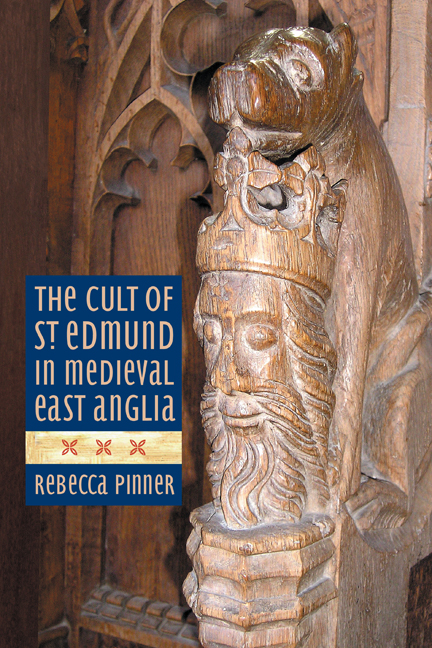Book contents
- Frontmatter
- Contents
- List of Illustrations
- Acknowledgements
- Abbreviations
- Introduction
- Part I Texts and Contexts: the Legend of St Edmund
- Part II Relics, Shrines and Pilgrimage: Encountering St Edmund at Bury
- Part III Beyond Bury: Dissemination and Appropriation
- Conclusion: ‘Martir, Mayde and Kynge’, and More
- Appendix 1 Synoptic Account of the Legend of St Edmund
- Appendix 2 Chronology of Significant Events and Texts Associated with the Cult of St Edmund
- Bibliography
- Index
Conclusion: ‘Martir, Mayde and Kynge’, and More
Published online by Cambridge University Press: 21 May 2021
- Frontmatter
- Contents
- List of Illustrations
- Acknowledgements
- Abbreviations
- Introduction
- Part I Texts and Contexts: the Legend of St Edmund
- Part II Relics, Shrines and Pilgrimage: Encountering St Edmund at Bury
- Part III Beyond Bury: Dissemination and Appropriation
- Conclusion: ‘Martir, Mayde and Kynge’, and More
- Appendix 1 Synoptic Account of the Legend of St Edmund
- Appendix 2 Chronology of Significant Events and Texts Associated with the Cult of St Edmund
- Bibliography
- Index
Summary
‘Blyssyd Edmund, kyng, martir and vyrgyne,
Hadde in thre vertues by grace a souereyn prys,
Be which he venquysshed al venymes serpentine.’
THIS book has demonstrated that the tripartite epithet repeated by Lydgate throughout the Lives does an injustice to the nature and complexity of the medieval cult of St Edmund. He was indeed a royal virgin martyr, but implicit in these terms are a multitude of subtle nuances and inflections that indicate the vitality of Edmund's cult over nearly six and a half centuries.
My stated intention was to explore how, why and when the cult developed. What has become strikingly apparent is that it is not possible to separate these three lines of enquiry. As a constructed saint (to borrow Delooz's term), everything we know about ‘saint’ Edmund is mediated through the individuals and communities who wrote about him, painted him, sculpted images of him, processed in his name and prayed at his tomb. In studying the cult of a medieval saint we are in fact studying the societies in which the holy man or woman was venerated. The plural is important, as in addition to acknowledging the social setting of cultic development we must also pay attention to the various origins and agendas of those involved. Considering the cult from a variety of perspectives has thus facilitated a greater understanding of the ways in which Edmund's saintly identity developed in response to particular circumstances.
Audience and reception
Part I attests to the value of a longitudinal approach to saints’ cults. Reading these lives in relation to hagiographic patterns identified in other cults indicates that whilst Edmund's life developed in line with some devotional trends, in many ways his cult was distinctive. The influence of the monastic community at Bury is overwhelmingly apparent, as most iterations of the legend were composed at or for the abbey. Rare and precious manuscripts were largely the preserve of ecclesiastics and the secular elite, who were therefore the most likely to encounter Edmund in this context. High-status lay interaction is evident, whether through the commissioning and design of manuscripts of Lydgate's Lives, listening to a vernacular version adapted for their benefit by Henry of Avranches or being allowed to view the sumptuous illustrations of Pierpont Morgan 736.
- Type
- Chapter
- Information
- The Cult of St Edmund in Medieval East Anglia , pp. 239 - 245Publisher: Boydell & BrewerPrint publication year: 2015



